Menus
- Two European three-cylinder against four four-cylinder from Japan
- MOTORCYCLE scoring
- Test result
- Technical data: Honda, Kawasaki
- Technical data: MV Agusta, Suzuki
- Technical data: Triumph, Yamaha
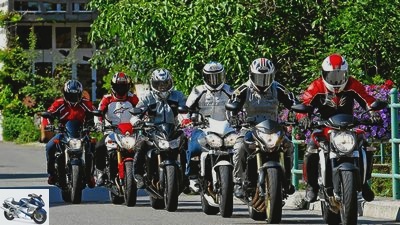
fact
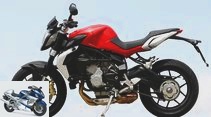
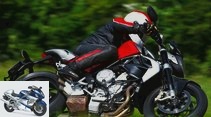
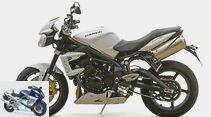
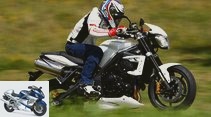
42 photos
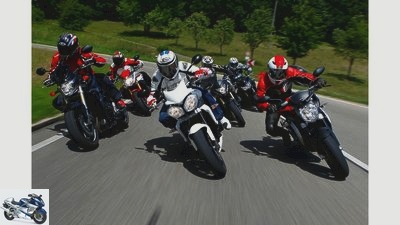
1/42
The shadow follows as best it can. The joy of movement, the joy of driving, dancing on the lean – this is what the dynamic sextet of Triumph Street Triple R, Honda Hornet 600, Suzuki GSR 750, Yamaha FZ8 50th Anniversary, Kawasaki Z 750 R Black Edition and MV Agusta Brutale 675 stand for.
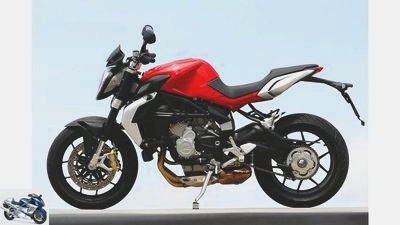
2/42
MV-Agusta: Wiry, muscular and light 185 kilograms: pure promise of driving dynamics.

3/42
“Charm is beauty in motion”, said Lessing once. Fits perfectly to the highly agile, almost bulky three-cylinder MV. Motion and emotion in one unit.
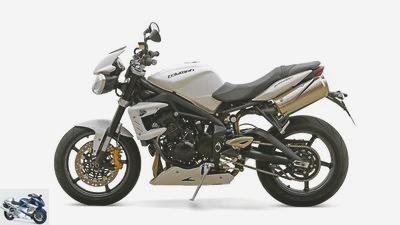
4/42
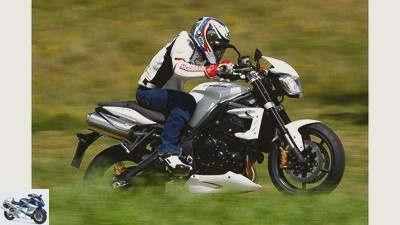
5/42
Addition: In 2012 there will be front spoiler, instrument and radiator covers for free.
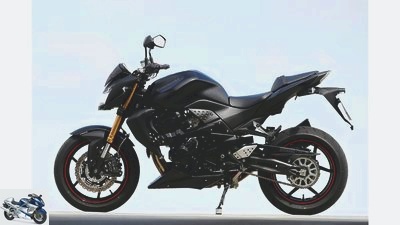
6/42
Kawasaki Z 750 R Black Edition: Black Beauty: Front spoiler, plenty of matt black paint and red rim rings.
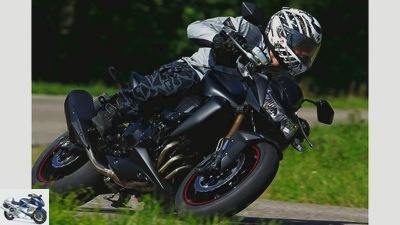
7/42
Black soul or black magic? This version of the 750 Kawa makes a streetfighter attitude especially. And a convincing driver.
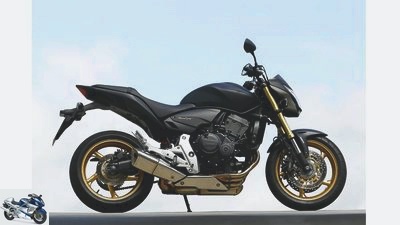
8/42
Honda Hornet 600: harmony of contrast: golden rims meet elegant, matt black paint.
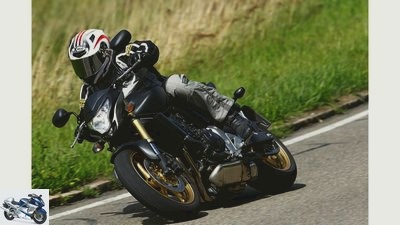
9/42
Deadline. Since 2011, headlights and cockpit have been sitting together in an insect head-like lamp mask. Huge: front silencer pulled far to the left.
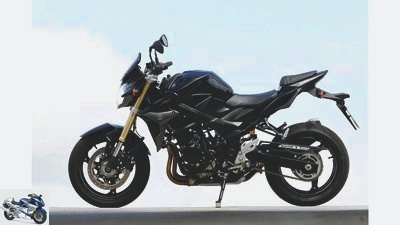
10/42
Suzuki GSR 750: cool or crude? Jagged, jagged design and cheap steel box swingarm.
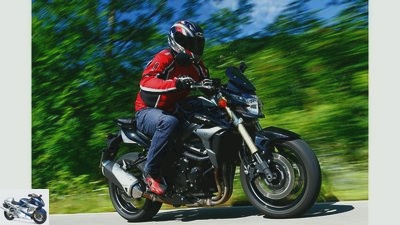
11/42
A great guy from the engine in the not entirely successful chassis: powerful four-cylinder meets a seating position that takes getting used to and a not very neutral chassis.
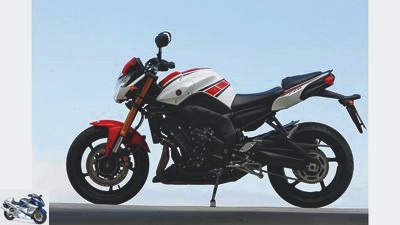
12/42
Yamaha FZ8 WGP 50th Anniversary: Simply beautiful: The traditional Yamaha factory colors suit the FZ8 beguilingly well.
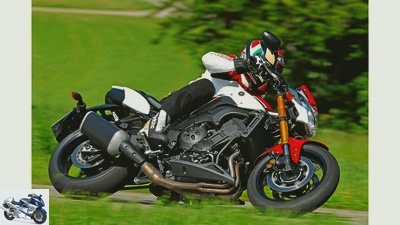
13/42
It is possible: If you take a bold step, you can also burn the Fast-800. On its own, the FZ8 turns in rather sluggishly, and its engine is not a paragon of pure temperament either.
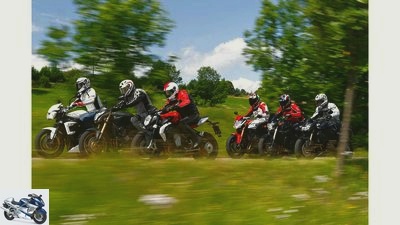
14/42
Triumph Street Triple R, Honda Hornet 600, Suzuki GSR 750, Yamaha FZ8 50th Anniversary, Kawasaki Z 750 R Black Edition and MV Agusta Brutale 675.
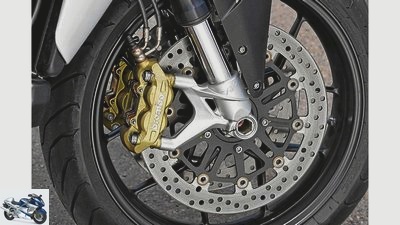
15/42
MV Agusta: Brembo’s golden four-piston stoppers anchor degressively: They brake hard at first, but do not build up a corresponding deceleration when the lever is pulled harder.
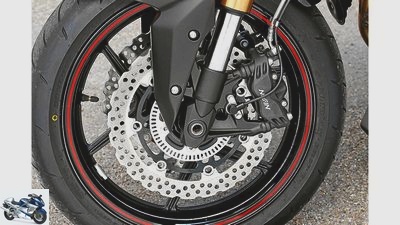
16/42
Kawasaki: The only Japanese radial brakes in the field: the four-piston stoppers bite effectively and properly metered on the disks with a hip serrated edge.
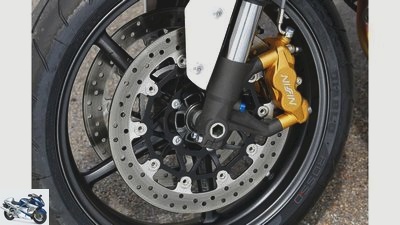
17/42
Triumph: The best brakes of the comparison: Nissin’s four-piston calipers bite transparently and powerfully, actuated by a radial pump and steel flex lines.
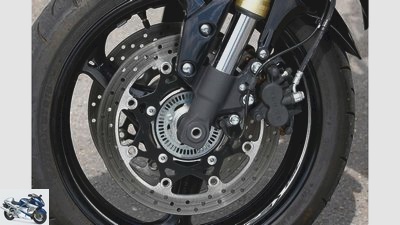
18/42
Suzuki: The simple double-piston floating calipers are not up-to-date – their braking power is low, the controllability is doughy. And the ABS could regulate more finely, please.
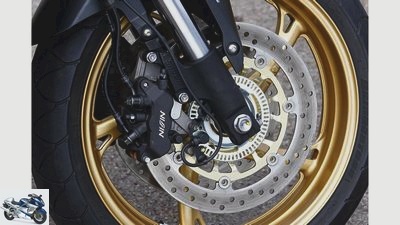
19/42
Honda: Strong together: the middle brake piston at the front right activates the brake pedal. The effect is good, the dosage should be even better, more sensitive.
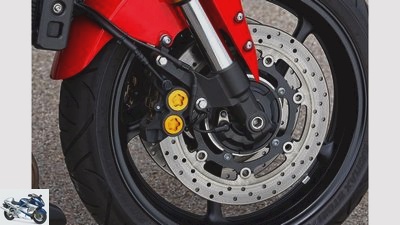
20/42
Yamaha: Typical for Yamaha is the hidden sensor ring for the ABS. It regulates reasonably. And the four-piston stoppers are reliable partners, not angry walkers.
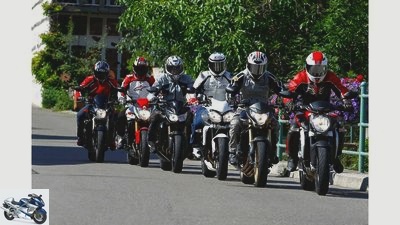
21/42
Power paradox: When pulling through in sixth gear, the 675 three- 750 four-cylinder engines.
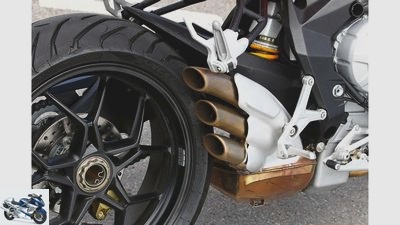
22/42
MV Agusta: Single-sided swing arm and three short organ pipes on the large exhaust collector give a view of the beautiful MV cast wheel.
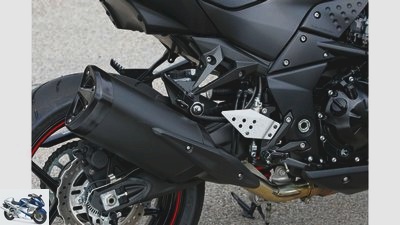
23/42
Kawasaki: Finely crafted two-armed swingarm and wildly jagged rear end of the Kawasaki.
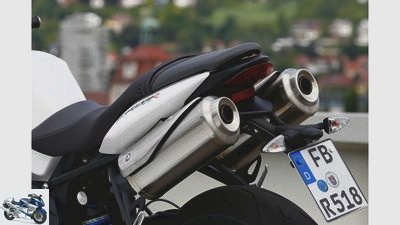
24/42
Triumph: Only the Triumph has two silencers under the bolted rear frame. In 2013 the exhaust moves under the engine.
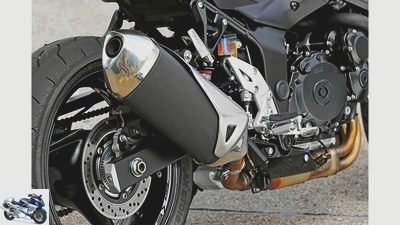
25/42
Suzuki: The Suzuki muffler is steep, steel box swingarm and chain tensioner are cheap.
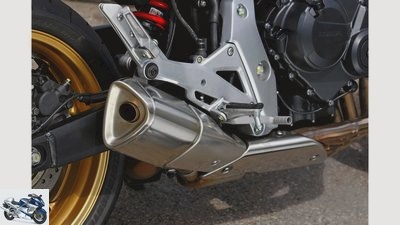
26/42
Honda: Neat aluminum swingarm on the Hornet, including a triangular muffler knob.
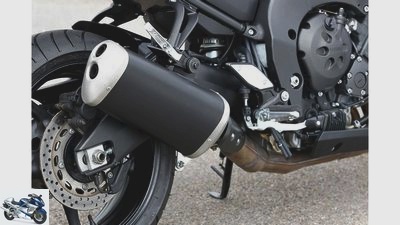
27/42
Yamaha: The stovepipe of the FZ8 is neither visually nor acoustically convincing. Your elegantly made aluminum swing arm, on the other hand, probably.
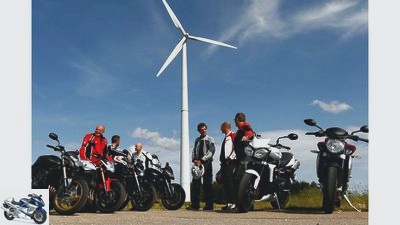
28/42
A breath of fresh air in the upper middle class. The four-cylinder engines are easier to handle, not least thanks to ABS. The triples, on the other hand, are more fiery.
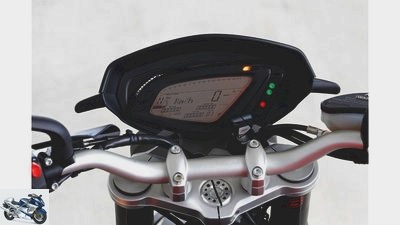
29/42
MV Agusta: Too small LCD scales in the MV cockpit. The bar rev counter is hardly readable, the gap dimensions to the lampshade are uneven.
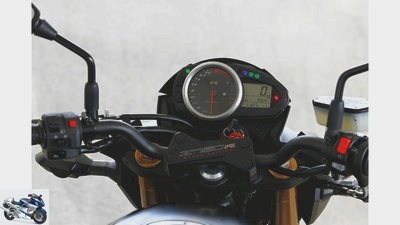
30/42
Kawasaki: Classically dominant, simply good, is the Kawa tour counter.
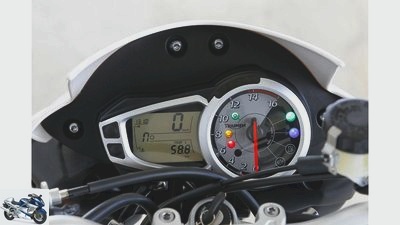
31/42
Triumph: informative and playful Triumph displays with on-board computer, stopwatch and fiddly controls. As with the MV, there is no fuel gauge.
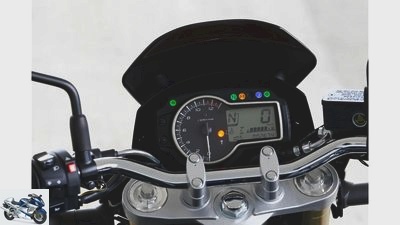
32/42
Suzuki: Only the GSR, like Brutale and Street Triple, has a practical gear indicator.
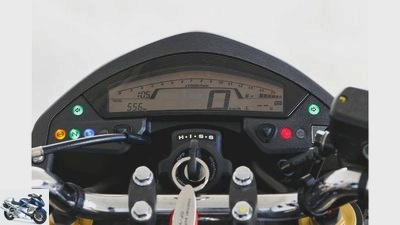
33/42
Honda: Bad readable LCD tachometer on the Hornet.
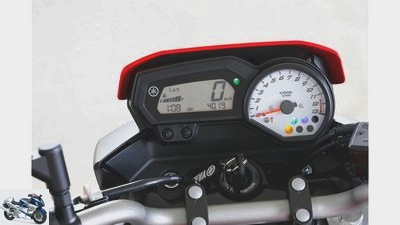
34/42
Yamaha: White highlighted round clock of the FZ8. Fuel gauges, hazard lights and immobilizers are a matter of honor for all four Japanese. OK then.
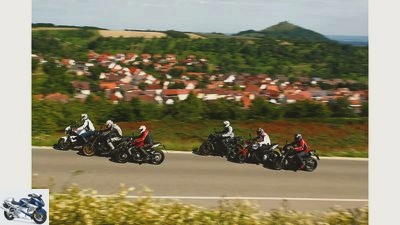
35/42
Triumph Street Triple R, Honda Hornet 600, Suzuki GSR 750, Yamaha FZ8 50th Anniversary, Kawasaki Z 750 R Black Edition and MV Agusta Brutale 675.
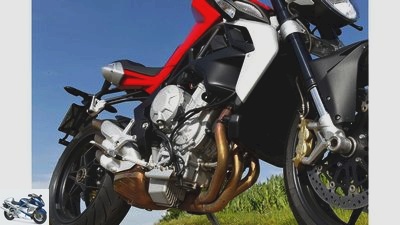
36/42
MV Agusta: Ultra-compact three-cylinder with oil and water cooler, cassette gear and selectable mappings. The housing surfaces are reminiscent of historical MVs.
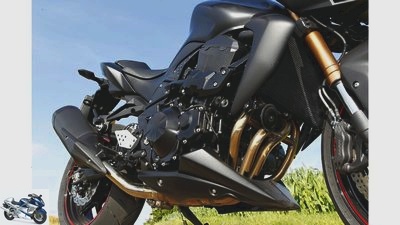
37/42
Kawasaki: Struts around the engine strengthen the frame. Belly pan in this version series, as in the Triumph and FZ8. Stainless steel elbows are standard in this class.
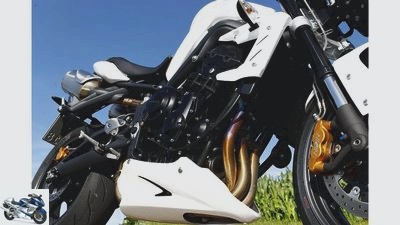
38/42
Triumph: proven, popular, inspiring – the longer-stroke three-cylinder feels like more displacement. As with the MV: superimposed gear shafts.
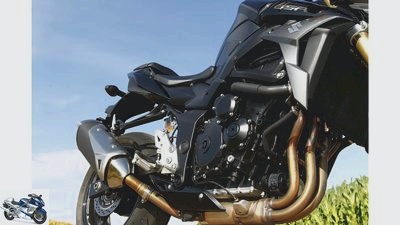
39/42
Suzuki: Classic sports engine construction for the former GSX-R unit: large bore, little stroke, slim appearance, huge water cooler. Everything quite powerful.
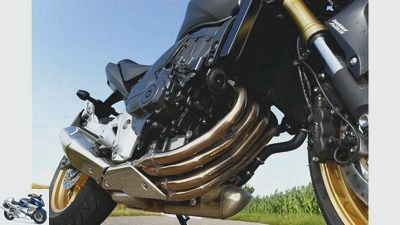
40/42
Honda: The four-cylinder comes modified from the 2007 CBR 600 RR. The smallest displacement also means the smallest piston with the smallest stroke. Elaborately parallel elbows.
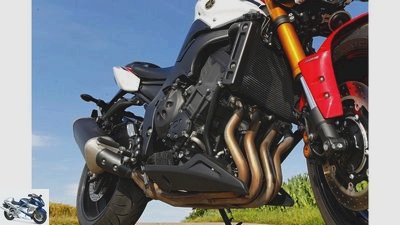
41/42
Yamaha: Visually, the displacement giant looks almost delicate. Its case is adorned with a hodgepodge of screws. Jagged, slim manifold and steeply inclined cylinders.
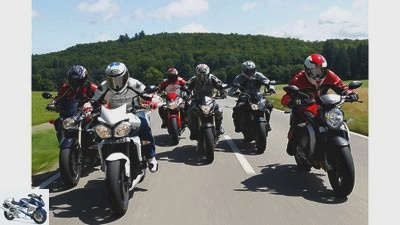
42/42
The Triumph Street Triple R wins the group test: Streetfighter or flatterer? The light English naked bike can do both, inspires beginners and professionals. One of the best motorcycle engines ever with a fully adjustable chassis. All of this will also be available with ABS from 2013!
Middle class naked bikes 2012
Two European three-cylinder against four four-cylinder from Japan
What people feel while driving is almost more important than what they are driving. This is especially true for these light, active roadsters for around 9,000 euros and up to 110 hp. With the brand new MV Agusta Brutale 675, cultures and technical philosophies collide: two European three-cylinder against four four-cylinder from Japan. So six correct ones for golden days?
Finally blue sky and sun, warmth and bliss in abundance. Saddle up motorbikes and get out with the six escape helpers from the big city! With driving machines par excellence, six speedsters and roadsters of low weight, 185 to 228 kilograms, and still manageable costs. Even the brand new MV Agusta Brutale 675 fits nicely into the 9,000 euro class. Here the affordable arsonist meets the Triumph Street Triple R with the same size three-cylinder. The triple duo faces the culture war with the four well-established, fully-fledged Japanese four-cylinders from 600 to 779 cubic meters.
This quartet is made up of the Honda Hornet 600, Kawasaki Z 750 R Black Edition, Suzuki GSR 750 and Yamaha FZ8 WGP 50th Anniversary. Phew, what a cumbersome name for the fine anniversary model. All four are considered user-friendly top sellers across Europe. A point of honor for the mature and popular Japanese models to compete with standard ABS, detailed fuel gauges and hazard warning lights. Safety first. More than a question of faith: if you ever need ABS, it has already paid off. So it is criminal that MV and Triumph are still missing. They throw more charisma into the race thanks to their more exclusive engines. Is that enough?
Buy complete article
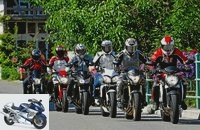
Middle class naked bikes 2012
Two European three-cylinder against four four-cylinder from Japan
“Charm is beauty in motion”, said Lessing once. Fits perfectly to the highly agile, almost bulky three-cylinder MV. Motion and emotion in one unit.
MV Agusta Brutale 675
She deserves the right of way. A dream in MV’s traditional factory colors silver and red. A work of art on wheels, beguilingly beautiful. 2.07 meters full of grace, with gifted shapes and inspiring curves. Italian women know how to arouse desire. So be careful: Just the MV has no immobilizer … The Brutale 675 wears its narrow three-cylinder (and also some electrical plugs) openly and heartbreakingly. It is wrapped in the little black dress, a tight mesh of tubular steel frames with flanged aluminum cast parts.
Noble and exclusive: the only one-sided swing arm of the sextet. And the most sensual exhaust, with the three short organ pipes. There are only a few cheap parts on the other hand, such as the rickety clutch lever, for fine details such as radiator grills made of brushed aluminum. Aesthetics meet filigree compactness in the 185 kilo flea. Nevertheless, even 1.91-meter drivers are well accommodated and balanced. The narrow tank leaves space for long legs, and the 79 centimeter wide, conical aluminum handlebar is easy to use. You sit close to the front wheel, but you don’t immediately feel about it.
The engine runs a bit mechanically. In idle it sounds restrained, slightly sawing: the idle is not completely even. Maintaining a constant speed is a real challenge with the purely electronic throttle grip. Approach the next in a controlled manner. Either the B3 falls into a torque hole when the clutch is engaged, or it roars from the spot with far too much smack: the throttle response is delayed at the bottom, but snappy, ultra-direct at high speeds. Simply inharmonious. Getting used to it goes better, but not well.
Mind you, everything in level “S” like sport from four selectable mappings. In it, the throttle valves follow the throttle hand most directly. The MV goes like a pig. Did you pull the cable carelessly in first gear? Then she slams the front wheel in your face.
The ultra-short-stroke 675 rushes out of the airbox into the red area with a guttural roar, as if the corpse were after her. You can hardly keep up with the shift. The 110 hp three-cylinder with large 79 pistons doesn’t like to stroll around. It gets its great performance from its ultra-light weight and crisp, short overall gear ratio: with 100 things in sixth gear, it turns almost 6000 tours. In this way he successfully conceals his not-so-abundant performance development.
Simply phenomenal, the way the MV swings lively over curves of all radii. Telepathically it falls into a lean position at the slightest steering impulse, and folds down very easily. So agile, so direct, so handy. This is the real MV experience. Are you looking for a handling-enhancing geometry? This is where the shortest wheelbase meets the, together with the Triumph, the steepest steering head angle and the shortest caster. For some drivers, however, all of this already seems over-motivated, nervous to fickle. The Italian immediately uses every twitch on the handlebars as a course correction. And on mogul slopes, the tightly tuned chassis accepts interference impulses all too willingly. The classy red will not iron the asphalt smooth for you. Instead, you fold yourself mentally, make you submissive, sound out limits.
The chassis remains true-to-line and neutral only on picture-perfect asphalt. The fork responds a bit stiffly, the stiff suspension strut is unyieldingly hard. The same applies to the board of a bench. After two hours at the latest, the buttocks ask for grace, for a break. What the MV celebrates is the perfect Sunday morning round with a lot of admiration potential at the motorcycle meeting place. This is how the Baby Brutale works: demanding, highly emotional, demanding. A dream only for enthusiasts.
Addition: In 2012, there will be front spoiler, instrument and radiator covers for free with the Triumph.
Triumph Speed Triple R.
“Wroop, wroop, wroop” – the sound echoes back from rock faces, three-cylinder tubes blow dry the cilia, hissing and slightly smoky. This alone gives the 675 three-cylinder goose bumps. And that’s just the beginning. Because the sound experience comes with moving propulsion. This triple reacts wonderfully spontaneously to every turn of the throttle, takes the gas directly and absolutely linearly. Hmmm, conventional throttle control cables aren’t that bad. And the less radical stroke-bore ratio is obviously good for the Triumph three-cylinder too.
The treble turns up loosely and easily. He is a strong and magnificent guy, fully there from 2000 to 12,000 tours. Powerful and easy to turn. The Triple develops its power linearly and casually. Ideal for practicing wheelies only when requested. Shift lazy can move the Streety. Fortunately: Because the English transmission is gnarled and sluggish and needs strong kicks, especially when downshifting. Annoying. Only a look at the gear indicator reveals that sixth gear is already there …
Five years ago, in July 2007, the Street Triple appeared. Since then, the “Mini-Speed-Triple” has blossomed into a new English style icon as a baby boomer, with pentagonal double headlights since 2011. Middle class with a lot of flair and finesse. This is especially true for the R version, which came as a premium version in 2008. It has better, fully adjustable spring elements and radially screwed four-piston stoppers from Nissin at the front. A chassis that really inspires.
Great feedback meets sensitive responses. You can feel the road relief one to one without suffering from it, you notice exactly what is happening. The shock absorber responds even better with a pillion passenger.
There is also great handiness. The 191-kilogram Triumph easily steers onto its Pirelli Diablo Rosso. And remains precise and Swedish neutral even on undulating terrain. But if necessary, the Triumph willingly accepts course corrections in an inclined position without ever becoming as nervous as the MV. Everything is very easy, playful. Sticking to the Brutale’s rear wheel is an easy exercise that the four-cylinder engines struggle to follow.
You can rely on the best brakes of the comparison in terms of effectiveness and controllability. Only for inexperienced users the snappy stoppers could be too much of a good thing. Everything on the 675 is aggressive and direct. ABS and deep exhaust only get the 2013 model. But the current Streety already conveys complete trust. The relaxed, almost upright seating position fits young and old and is well integrated into the motorcycle.
Criticisms? The seat is comfortable, but a little higher than the others (83 centimeters), the footrests are a tad back. And the turning circle should be even smaller, the MV sends its regards. Nevertheless: This triumph delivers what the low-wage internet retailer Zalando only promises: You scream with happiness. And not because only here are both hand levers adjustable or, as otherwise only on the MV, cranked tire valves on board.
And the cost? An additional 1000 euros for the “R” on the standard version, 9090 instead of 8090 euros, is well invested, the price is fully within the framework. Triumph only costs 370 euros for ancillary costs, about twice as much as with Kawasaki, Suzuki and Yamaha. Well, you pay for an unmatched range of riding skills, for a big hit: a motorcycle that is easy to drive, offers a lot of riding fun and fits almost everyone, beginners and experts. An enormous range of uses. Well done, triumph.
Honda: Since 2011, headlights and cockpit have been sitting together in an insect head-like lamp mask. Huge: front silencer pulled far to the left.
Honda Hornet 600
Let’s say hello to the third European. Yes, because the Hornet 600 comes from Honda’s factory in Atessa / Italy. Stylish, chic, bold, designed by Italian designers. In 2011 it was further enhanced, the crisp lines sharpened, the already airy and cheeky rear slimmed down even further, the lamp mask smoothed and immediately equipped with a new cockpit. Current LCD tachometers are a disease at Honda, a pixel epidemic that is difficult to read. The classic round instrument until 2010 was better. At least the golden rims are in fine contrast to the matt black paint.
The last small 600 engine in the new middle class needs, of course, speed. It was tamed out of the current CBR 600 RR. Down below he strives honestly, wakes up from 4000, comes alive at 7000. There, the short translation heaves it up at 125 km / h in the sixth. In hairpin bends, Hondas Benjamin likes to call for first gear. More capacity is simply more. -Basta. In order to make rapid progress, the row quad, which is neatly attached to the gas, has to be turned and switched diligently. Healthy shift feet warmly welcome!
No problem, the clutch and gearshift are flawless because they run smoothly and precisely. Only the idling speed after a cold start should be less than a high 2500 rpm.
The exhaust pipe is favorable to the center of gravity because it centers the masses: Manifolds that are inclined to the right lead into two front silencers with a blunt “exhaust torpedo” on the front left. From there it goes back to the short stub end pot. Praiseworthy: the maintenance intervals, which have been extended to 12,000 kilometers (!) Since 2011, with significantly reduced deadlines. great.
Functionally, the chassis turned out to be around the aluminum backbone frame. The lightest four-cylinder engine (207 kilograms) sticks out into the thicket of bends, light-footed, if not very handy. Maybe the 600 with wider handlebars would be easier to handle – it’s pretty narrow. Or with a less wide tire, the 180 rear is class standard, looks mighty important under the tiny rear. But probably a 160 would do the same.
The hornet travels its course as stably as it is precisely steered. Highly reliable. She remains pretty unimpressed even by rough road warps. And this despite the fact that the shock absorber is directly hinged. All others have a progressive deflection.
The slim waistline gives drivers less than 1.80 meters safety, and the compactly modeled tank flanks allow good knee grip. Honda can do good ergonomics. The Hornet has a simple combination brake: just stepping on the pedal activates the middle of the three brake pistons in the right saddle. The effect is okay, but the pressure point when pulling the hand lever should be clearer and crisper.
A shame: With measured 99 PS, the nominally 102 PS strong Hornet just falls out of the cheap 98 PS insurance class. Friendly: Until the end of September, the sporty naked bike costs only 7990 euros, all inclusive – a saving of 865 euros. The 600 series should build on old successes in Germany, which is spoiled for displacement: its predecessors were among the best-selling models in Europe.
Black soul or black magic? This version of the 750 Kawa makes a streetfighter attitude especially. And a convincing driver.
Kawasaki Z 750 R Black Edition
The message from the Kawa is clear: Here comes the bad boy of the field, a fighter. Upgrades to the chassis, brakes and design make the R a noble version of the 750, in the Black Edition completely wrapped in dark macho matt black. The coolness factor is right. The smoky, dark voice of the 106 hp four-cylinder engine goes well with this. The muffler with exhaust flap grumbles throaty and dull: “You are Kawasaki.” The engine accelerates smoothly. Its oval additional throttle valves, which are controlled by the on-board computer, are intended to smooth the throttle response. Works pretty well, only in push mode does the set forward a little harder.
In general, the engine should still hang a little more greedily on the gas. It comes unchanged from the basic Zett. After the cold start, he needs a few seconds to recover. Even when warm, the 750 under five or six thousand is not as snappy and aggressive as its streetfighter image promises. Only then does the Kawa really get down to business, now storms forward with a hoarse hiss from the exhaust and airbox. The front-wheel-oriented, slightly combative sitting posture comes in handy. Crisp. The hard, over-designed seat calls for accepting qualities. You sit selectively, not very fluffy. The pillion seat slopes down like a roof to the left and right. Who comes up with that? On the other hand, this test copy drives really well, as if transformed compared to the previous Z 750 R. Although nothing seems to have changed.
For all Rs, the fork, strut with expansion tank and aluminum instead of steel swing arm come from the 2009 version of the Z 1000. The same applies to the radial four-piston brake calipers at the front. Crispy.
Furthermore, the rocker arm of the strut is different from that of the base 750. The spring elements respond well and provide good information about the asphalt condition. The damping is full without being uncomfortable; the rebound stage can be varied at the front and rear. In the winding curve, this Z sets itself in scene really well, remains more neutral than the GSR. In addition, the chassis offers more reserves than that of the FZ8. When turning, however, the Kawa cannot hide its heavy 228 kilos, they are a clear “class record”.
Grabbing is the order of the day. The fact that the Z stands up noticeably on bumpy asphalt in an inclined position and when braking is probably due to its aging Dunlop D 210. The four-piston stoppers bite on the thick wave brake discs with a pressure point that you can feel. And that is atypically Japan operated by steel braided lines. The ABS regulates pretty well.
The Black Edition is 200 euros more expensive than a normal Z 750 R, yes, for a total of 9475 euros even the most expensive machine in this comparison. Well, Kawasaki is floating on a wave of success in Germany, calling up proud prices.
Suzuki: A great guy from the engine in the not entirely successful chassis: Powerful four-cylinder meets a seating position that takes getting used to and a not very neutral chassis.
Suzuki GSR 750
A test is always a questionnaire for the designers. The only difference is that this time the answers are a little different than they were last in MOTORRAD 10/2011. But one after the other. Jagged, rugged, peppy, playful: the GSR 750 with its many small design elements parked casually on the side stand. From the start, your fine four-cylinder is full of music, is highly motivated on the gas, sensitive, soft and powerful. Cultivated and emphatic, he pushes, driving in the second best acceleration after the street triple. Even when pulling through in sixth gear, Suzuki’s silky powerhouse dominates over the other four-cylinder, only has to let the two triples go.
The rather short-stroke yet powerful engine comes from the 2005 GSX-R – modified for the new purpose. He is a great success and a source of joy. Especially because if you drive carefully on the country road, you can get by with a good four liters of fuel – a round half liter less than the other four-cylinder and over a liter less than the triples. Little fuel, lots of thrust.
The chassis does not show itself quite as well. A steel frame is okay, MV and Kawasaki have too. But a welded rear frame and a cheap box swing arm made of steel bear witness to the savings dictate. The GSR, which weighs 215 kilograms, turns easily. But once thrown in an inclined position, it defends itself against a new line of choice, stiffens itself while briskly waving. To do this, she moves on bumps, looks for other radii on her Bridgestone BT 016 with the special code “EE”. Neutral is different. Feels like the motorcycle buckles in the steering head. When driving fast you don’t hit a line exactly. Motto: You can get out of somewhere. On the highway, the GSR is also latently prone to commuting, at least if you sit far back.
So it’s better to slide forward on the spacious bench. The tank spreads its legs wide, the footrests are high, the rubber handlebars are far away. Reminiscent of superbikes from the 80s, but prevents perfect contact with the motorcycle. The brakes also act stale. The simple double-piston floating calipers appear strangely blunt when the toppings are put in place, and can only be doughy. There’s better. So the 750 makes too little of its great engine. Nevertheless, it was the best-selling Suzuki in Germany in the first half of 2012. compliment.
It is possible: If you take a bold step, you can also burn the Fast-800. On its own, the FZ8 turns in rather sluggishly, and its engine is not a paragon of pure temperament either.
Yamaha FZ8 WGP 50th Anniversary
Quite clear: With this fine paintwork, the FZ8’s hearts fly to the standstill – white-red-black factory colors on – for the 50th anniversary of the GP in 2011. Simply classy and elegant. A geisha in velvety lingerie. Visually very attractive for a moderate 300 euros extra charge. In general, the Yamaha FZ8 offers a lot of motorcycle for the money. Because it is basically an FZ1 shrunk to 779 cubic meters. The big sister donated the posh aluminum frame with the screwed rear and the shapely, powerfully stable banana swing arm. Plus the basic design of the four-cylinder. Except that the 800 series has smaller pistons with the same stroke and a four-valve head instead of the five-valve head. The engine purrs gently out of the somewhat clumsy silencer.
In terms of driving dynamics, the four-cylinder only acts as the king of displacement in the test field to a limited extent. Although it pushes nice and even from a standstill, it increases with the strongest starting torque at 2500 tours. But at twice the speed it falls into a small hole. Then the 750s from Kawasaki and Suzuki outstrip the brave Yamaha, before it gets down to business at 6000 tours and unpacks the really big club in the form of 79 Newton meters at 8000 rpm. A great value for 779 cubic meters. The Yamaha needs even less speed than the Z 750 R and GSR for the same speed in sixth gear. In return, the large FZ8 can only outperform the small 600 Hornet in acceleration and pulling power with great difficulty. The Yamsel is a great motorcycle for people who don’t like to be surprised, just looking for a great buddy.
Because the wiry, sinewy, 216 kilogram light FZ8 drives good-naturedly, leaves nothing to be desired in normal operation. Their soft spring elements offer the best suspension comfort. Only when driving at a speedy driving style that jeopardizes the driver’s license does some movement come into the chassis. The cozy 800 turns a little sluggishly. No wonder, given the chassis geometry of the 1000: This is where the largest wheelbase, longest caster and flattest steering head come together.
On pocky streets, the FZ8 tends to look for lines for itself. And the shock absorber soon kneels with a pillion passenger. It’s a shame, the soft damping is not adjustable, you can only lift the spring base at the back.
After all, the handlebars are well at hand and well cranked. If you come from the MV, the soft seat cushion of the FZ8 is humanism in action. But after two hours it wore off. Then it tweaks and tweaks. Especially since the wide Deltabox frame, which heats up quite a bit in summer, also spreads the legs wide: the knees are just as wide as the hands. The 800 feels like a lot of motorcycle in every way. On the positive side, there is steadfast directional stability, good brakes and considerate mirrors. Whether such everyday qualities make the FZ8 the second most popular Yamaha in this country, after the XJ6?
A breath of fresh air in the upper middle class. The four-cylinder engines are easier to handle, not least thanks to ABS. The triples, on the other hand, are more fiery.
Conclusion
A differentiated picture: the two three-cylinders frame the field of four four-cylinders – front and rear. The thrilling Triumph Street Triple R sets itself apart from the other five. And that still without ABS, which will only be introduced to the Englishwoman at the end of 2012. Behind it, the Honda Hornet 600 proves how you can make a lot out of little (namely, displacement). If only the construction is balanced and harmonious.
The MV Brutale 675 is far from that. You love or hate them: super handling or nervous diva, lousy gas control or enthusiastic unleashed revving – everyone has to decide for themselves. No test winner material, but pure passion. A lot of fascination, few compromises.
The four recognized, durable four-cylinder engines are more modest and more sociable in everyday life. Not just because of ABS. Despite the extra kilos, Kawasaki, Suzuki and Yamaha remain at least as user-friendly compared to the three machines with European roots. The three big ones offer a lot of utility and motorcycle for the money. In positive terms, they are good-natured and grown-up, in negative terms, despite their streetfighter attitude, they are more cumbersome.
MOTORCYCLE scoring
The Triumph Street Triple R wins the group test: Streetfighter or flatterer? The light English naked bike can do both, inspires beginners and professionals. One of the best motorcycle engines ever with a fully adjustable chassis. All of this will also be available with ABS from 2013!
engine
Head to head. Street Triple and GSR accelerate best. In general, Suzi is hot on the heels of triumph. In the passage from the top, the Triumph only has to let the MV go. In addition, the throttle response of the little vibrating Brit bike is almost perfect, direct and always clearly visible. This is exactly the opposite of the Brutale’s Italo triplet with its clumsy ride-by-wire. The only weak point of the Triumph engine is its sluggish transmission. In the gear shift section, the low-torque Honda sets the record. Good thing, you have to stir a lot in their machinery. The FZ8 makes little of the largest displacement.
Winner engine: triumph
landing gear
Clear case. In this class, the fully adjustable Triumph chassis is the benchmark, setting the best values en masse: the Street Triple R arrows through corners with stability, precision and good feedback. Only it has fully adjustable spring elements at the front and rear, so it can be easily adapted to changing conditions. With both three-cylinder machines, the freedom from inclination cannot be explored. A motorcycle can hardly be handier than the Brutale 675. More stable than the almost wobbly MV on the other hand. The adjustment options are rudimentary with her and the FZ8 – only the rear spring base. The softly tuned Yamaha offers great suspension comfort.
Chassis winner: triumph
everyday life
Honda or Suzuki? In the end, the Hornet has a wafer-thin edge over the GSR. Because the 600 is nowhere weak, like the FZ8 donates good light and best embeds a passenger. Somewhat better wind protection thanks to accessory washers and the largest range speak for the moderately processed GSR. The FZ8 saddles the most payload, its rear-view mirrors offer the best view. Perhaps what counts most: The Triumph offers the most comfortable workspace, albeit with a slightly high seat. Even the extreme MV shines with good ergonomics, if only its seat wasn’t so miserably hard. Sitting on the FZ8 is comfortable, almost too soft.
Winner everyday life: Honda
security
If or but? The Street Triple R has the crispest brakes with the best controllability and the greatest reserves. But because they lack ABS, Honda and Yamaha triumph in the end. The Hornet, almost typical for Honda, combines a combination brake system and the best ABS. In contrast to the comfortable FZ8, the agile MV can also wedge hand-tight with the handlebar.
Safety winner: Honda / Yamaha
costs
Commendable. The Hornet offers long, 12,000 inspection intervals. MV and GSR are expensive to service. The mobility guarantee and low consumption of the Suzuki do not tear that out.
Winner cost: Honda
Price-performance
At least 1000 euros cheaper than the other five and really good at a special price, that’s how the Hornet shines.
Price-performance winner: Honda
| Max points | Honda | Kawasaki | MV Agusta | Suzuki | triumph | Yamaha | Overall rating | 1000 | 647 | 624 | 608 | 634 | 662 | 625 |
| placement | 2. | 5. | 6th. | 3. | 1. | 4th. | Price-performance note | 1.0 | 1.1 | 1.8 | 2, 0 | 1.5 | 1.3 | 1.6 |
Test result
Power paradox: When pulling through in sixth gear, the 675 three- 750 four-cylinder engines.
1st Triumph Street Triple R.
Platinum: Streetfighter or Flatterer? The light English naked bike can do both, inspires beginners and professionals. One of the best motorcycle engines ever with a fully adjustable chassis. All of this will also be available with ABS from 2013!
2. Honda Hornet 600.
Gold: Typically Honda, the Hornet works inconspicuously well, making it easy for the driver. Maintenance intervals of 12,000 and the promotional price under 8,000 euros make the David of the field very attractive. The only thing missing is a wider handlebar and a larger motor.
3. Suzuki GSR 750.
Silver: The great engine accelerates gently, pushes and pushes. Suzuki’s naked seventy-five combines good driving performance with the lowest consumption. But the chassis is not entirely convincing: the brakes are blunt, the handling is not very neutral.
4. Yamaha FZ8 50th Anniversary.
Bronze: The special model is the most beguiling Japanese offer in the upper middle class. At least optically. The engine makes too little of its displacement advantage. The chassis is comfortable and soft, but the shock absorber is a bit slack.
5. Kawasaki Z 750 R Black Edition.
Kupfer: From a driver’s point of view, we like the quite firm chassis and good brakes. In addition, the sound is more sonorous, not too loud. Only the Kawasaki hardly sets records, its seat is almost MV-moderately hard. Does everything also apply to such brightly colored Z 750 Rs …
6th MV Agusta Brutale 675.
Eisen: certainly the most sensual offer in this class, completely Italian. Blessed with inspiring driving dynamics and a grace that was previously unknown in this class. A lot of fascination for money. If only the three-cylinder with ride-by-wire only accelerated better …
Technical data: Honda, Kawasaki
Honda: The four-cylinder comes modified from the 2007 CBR 600 RR. The smallest displacement also means the smallest piston with the smallest stroke. Elaborately parallel elbows.
| Honda | Kawasaki | engine |
| design type | Four-cylinder, four-stroke in-line engine | Four-cylinder, four-stroke in-line engine | injection | Ø 36 mm | Ø 32 mm |
| coupling | Multi-disc oil bath clutch | Multi-disc oil bath clutch | Bore x stroke | 67.0 x 42.5 mm | 68.4 x 50.9 mm |
| Displacement | 599 cm3 | 748 cm3 | compression | 12.0: 1 | 11.3: 1 |
| power | 75.0 kW (102 hp) at 12,000 rpm | 77.7 kW (106 hp) at 10500 rpm | Torque | 64 Nm at 10500 rpm | 78 Nm at 8300 rpm |
| landing gear | frame | Backbone frame made of aluminum | Bridge frame made of steel |
| fork | Upside-down fork, Ø 41 mm | Upside-down fork, Ø 41 mm | Brakes front / rear | Ø 296/240 mm | Ø 300/250 mm |
| Assistance systems | SECTION | SECTION | bikes | 3.50 x 17; 5.50 x 17 | 3.50 x 17; 5.50 x 17 |
| tires | 120/70 ZR 17; 180/55 ZR 17 | 120/70 ZR 17; 180/55 ZR 17 | Tires | Bridgestone BT 012 “J” | Dunlop D 210, front “G” |
| Dimensions + weights | wheelbase | 1435 mm | 1440 mm |
| Steering head angle | 65.0 degrees | 65.5 degrees | trailing | 99 mm | 103 mm |
| Front / rear suspension travel | 120/128 mm | 120/134 mm | Seat height ** | 810 mm | 810 mm |
| Weight with full tank ** | 207 kg | 228 kg | Payload ** | 188 kg | 179 kg |
| Tank capacity | 19.0 liters | 18.5 liters | Service intervals | 12,000 km | 6000 km |
| price | 8590 euros | 9095 euros | Price test motorcycle | Promotion price 7990 incl. Nk *** | 9295 euros **** |
| Additional costs | 265 euros | 180 euros | MOTORCYCLE readings |
| Top speed * | 230 km / h | 230 km / h | acceleration |
| 0-100 km / h | 3.5 sec | 3.7 sec | 0-140 km / h | 6.0 sec | 6.1 sec |
| 0-200 km / h | 15.2 sec | 14.3 sec | Draft |
| 60-100 km / h | 4.9 sec | 4.4 sec | 100-140 km / h | 5.3 sec | 4.9 sec |
| 140-180 km / h | 5.9 sec | 5.8 sec | Consumption highway | 4.5 liters / normal | 4.8 liters / normal |
| Reach country road | 422 km | 385 km |
* Manufacturer information; ** MOTORCYCLE measurements; *** Price promotion until September 30, 2012; **** Black Edition version (9295 euros); ***** including windshield (135 euros) and aluminum chain guard (100 euros); ****** since 1.2.2012 including equipment package consisting of instrument cover, radiator cover and engine cover; ****** WGP 50th Anniversary livery
Technical data: MV Agusta, Suzuki
MV Agusta: Ultra-compact three-cylinder with oil and water cooler, cassette gear and selectable mappings. The housing surfaces are reminiscent of historical MVs.
| MV Agusta | Suzuki | engine |
| design type | Three-cylinder four-stroke in-line engine | Four-cylinder, four-stroke in-line engine | injection | Ø 47 mm | Ø 32 mm |
| coupling | Multi-disc oil bath clutch | Multi-disc oil bath clutch | Bore x stroke | 79.0 x 45.9 mm | 72.0 x 46.0 mm |
| Displacement | 675 cm3 | 749 cm3 | compression | 12.1: 1 | 12.3: 1 |
| power | 80.9 kW (110 hp) at 12600 rpm | 78.0 kW (106 hp) at 10,000 rpm | Torque | 64 Nm at 8600 rpm | 80 Nm at 9000 rpm |
| landing gear | frame | Steel tubular frame | Bridge frame made of steel |
| fork | Upside-down fork, Ø 43 mm | Upside-down fork, Ø 41 mm | Brakes front / rear | Ø 320/220 mm | Ø 310/240 mm |
| Assistance systems | Traction control | SECTION | bikes | 3.50 x 17; 5.50 x 17 | 3.50 x 17; 5.50 x 17 |
| tires | 120/70 ZR 17; 180/55 ZR 17 | 120/70 ZR 17; 180/55 ZR 17 | Tires | Pirelli Angel ST | Bridgestone BT 016 “EE” |
| Dimensions + weights | wheelbase | 1380 mm | 1450 mm |
| Steering head angle | 66.0 degrees | 64.8 degrees | trailing | 95 mm | 104 mm |
| Front / rear suspension travel | 125/119 mm | 120/135 mm | Seat height ** | 810 mm | 820 mm |
| Weight with full tank ** | 185 kg | 215 kg | Payload ** | 179 kg | 185 kg |
| Tank capacity | 16.6 liters | 17.5 liters | Service intervals | 6000 km | 6000 km |
| price | 8990 euros | 8590 euros | Price test motorcycle | 8990 euros | 8825 euros ***** |
| Additional costs | 275 euros | 190 euros | MOTORCYCLE readings |
| Top speed * | 225 km / h | 225 km / h | acceleration |
| 0-100 km / h | 3.6 sec | 3.3 sec | 0-140 km / h | 5.9 sec | 5.7 sec |
| 0-200 km / h | 12.3 sec | 12.5 sec | Draft |
| 60-100 km / h | 3.8 sec | 4.3 sec | 100-140 km / h | 3.8 sec | 4.2 sec |
| 140-180 km / h | 4.5 sec | 5.2 sec | Consumption highway | 5.2 liters / super | 4.1 liters / super |
| Reach country road | 319 km | 427 km |
* Manufacturer information; ** MOTORCYCLE measurements; *** Price promotion until September 30, 2012; **** Black Edition version (9295 euros); ***** including windshield (135 euros) and aluminum chain guard (100 euros); ****** since 1.2.2012 including equipment package consisting of instrument cover, radiator cover and engine cover; ****** WGP 50th Anniversary livery
Technical data: Triumph, Yamaha
Triumph: proven, popular, inspiring – the longer-stroke three-cylinder feels like more displacement. As with the MV: superimposed gear shafts.
| triumph | Yamaha | engine |
| design type | Three-cylinder four-stroke in-line engine | Four-cylinder, four-stroke in-line engine | injection | Ø 44 mm | Ø 35 mm |
| coupling | Multi-disc oil bath clutch | Multi-disc oil bath clutch | Bore x stroke | 74.0 x 52.3 mm | 68.0 x 53.6 mm |
| Displacement | 675 cm3 | 779 cm3 | compression | 12.65: 1 | 12.0: 1 |
| power | 78.0 kW (106 hp) at 11700 rpm | 78.1 kW (106 hp) at 10,000 rpm | Torque | 68 Nm at 9200 rpm | 82 Nm at 8000 rpm |
| landing gear | frame | Bridge frame made of aluminum | Bridge frame made of aluminum |
| fork | Upside-down fork, Ø 41 mm | Upside-down fork, Ø 43 mm | Brakes front / rear | Ø 308/220 mm | Ø 310/267 mm |
| Assistance systems | – | SECTION | bikes | 3.50 x 17; 5.50 x 17 | 3.50 x 17; 5.50 x 17 |
| tires | 120/70 ZR 17; 180/55 ZR 17 | 120/70 ZR 17; 180/55 ZR 17 | Tires | Pirelli Diablo Rosso Corsa | Bridgestone BT 021 “BB” |
| Dimensions + weights | wheelbase | 1405 mm | 1460 mm |
| Steering head angle | 66.1 degrees | 65.0 degrees | trailing | 93 mm | 109 mm |
| Front / rear suspension travel | 120/130 mm | 130/130 mm | Seat height ** | 830 mm | 810 mm |
| Weight with full tank ** | 190 kg | 216 kg | Payload ** | 191 kg | 194 kg |
| Tank capacity | 17.4 liters | 17.0 liters | Service intervals | 10000 km | 10000 km |
| price | 9090 euros ****** | 8695 euros | Price test motorcycle | 9090 euros | 8995 euros ******* |
| Additional costs | 370 euros | 170 euros | MOTORCYCLE readings |
| Top speed * | 216 (225) 1 km / h | 218 km / h | acceleration |
| 0-100 km / h | 3.3 sec | 3.8 sec | 0-140 km / h | 5.6 sec | 6.4 sec |
| 0-200 km / h | 12.2 sec | 15.2 sec | Draft |
| 60-100 km / h | 3.7 sec | 4.5 sec | 100-140 km / h | 4.3 sec | 5.5 sec |
| 140-180 km / h | 5.2 sec | 5.9 sec | Consumption highway | 5.2 liters / super | 4.6 liters / normal |
| Reach country road | 335 km | 370 km |
* Manufacturer information; ** MOTORCYCLE measurements; *** Price promotion until September 30, 2012; **** Black Edition version (9295 euros); ***** including windshield (135 euros) and aluminum chain guard (100 euros); ****** since 1.2.2012 including equipment package consisting of instrument cover, radiator cover and engine cover; ****** WGP 50th Anniversary livery
Related articles
-
Middle class naked bikes in comparison test
r-photography.info 30 pictures r-photography.info 1/30 With the Z 900 Kawasaki pushes the middle class close to the full liter. Looks up …
-
Comparison test of naked bikes with ABS
fact Comparison test of naked bikes with ABS Veni, vidi, vici! In comparison tests and registration numbers, the all-rounders Honda CBF 600, Kawasaki…
-
Comparison test: naked bikes BMW, Ducati, Triumph, Yamaha, Kawasaki
fact 66 photos fact 1/66 If you want a real all-rounder, the Yamaha FZ8 is the right choice. fact 2/66 There is no trace of savings: despite the price,…
-
Comparative test of naked bikes 2013
fact 37 photos fact 1/37 Aprilia Shiver 750 ABS, Triumph Street Triple 675, Suzuki GSR 750, Kawasaki Z800, Yamaha FZ8, MV Agusta Brutale 800 and BMW F…
-
Artist Comparison test middle class Honda Hornet S. Kawasaki ZR-7 S. Suzuki GSF 600 S Bandit Yamaha FZS 600 Fazer Born to be mild Four days, 1913…
-
Comparison test of naked bikes from Japan
Artist 15th photos Artist 1/15 Artist 2/15 Artist 3/15 Artist 4/15 Artist 5/15 Artist 6/15 Artist 7/15 Artist 8/15 Artist 9/15 Artist 10/15 Artist 11/15…
-
Comparative test of mid-range naked bikes
Artist Comparative test of mid-range naked bikes Honda Hornet 600, BMW F 800R and Yamaha XJ6 There’s a lot going on in the middle class. The new center…
-
Power Naked Bikes in Comparison – Part 2
31 photos 1/31 BMW S 1000 R, Honda CB 1000 R, Kawasaki Z 1000, Suzuki GSX S 1000 and Yamaha MT 10 in the comparison test….
-
Comparative test of 800 naked bikes
31 photos 1/31 Winner price-performance ratio Yamaha MT-09: Most points and the cheapest price, that can only give the best…
-
90 hp naked bikes in a comparison test
fact 27 photos fact 1/27 One look at the performance diagram and it becomes clear: Even within the 90 hp middle class, there are worlds between the…